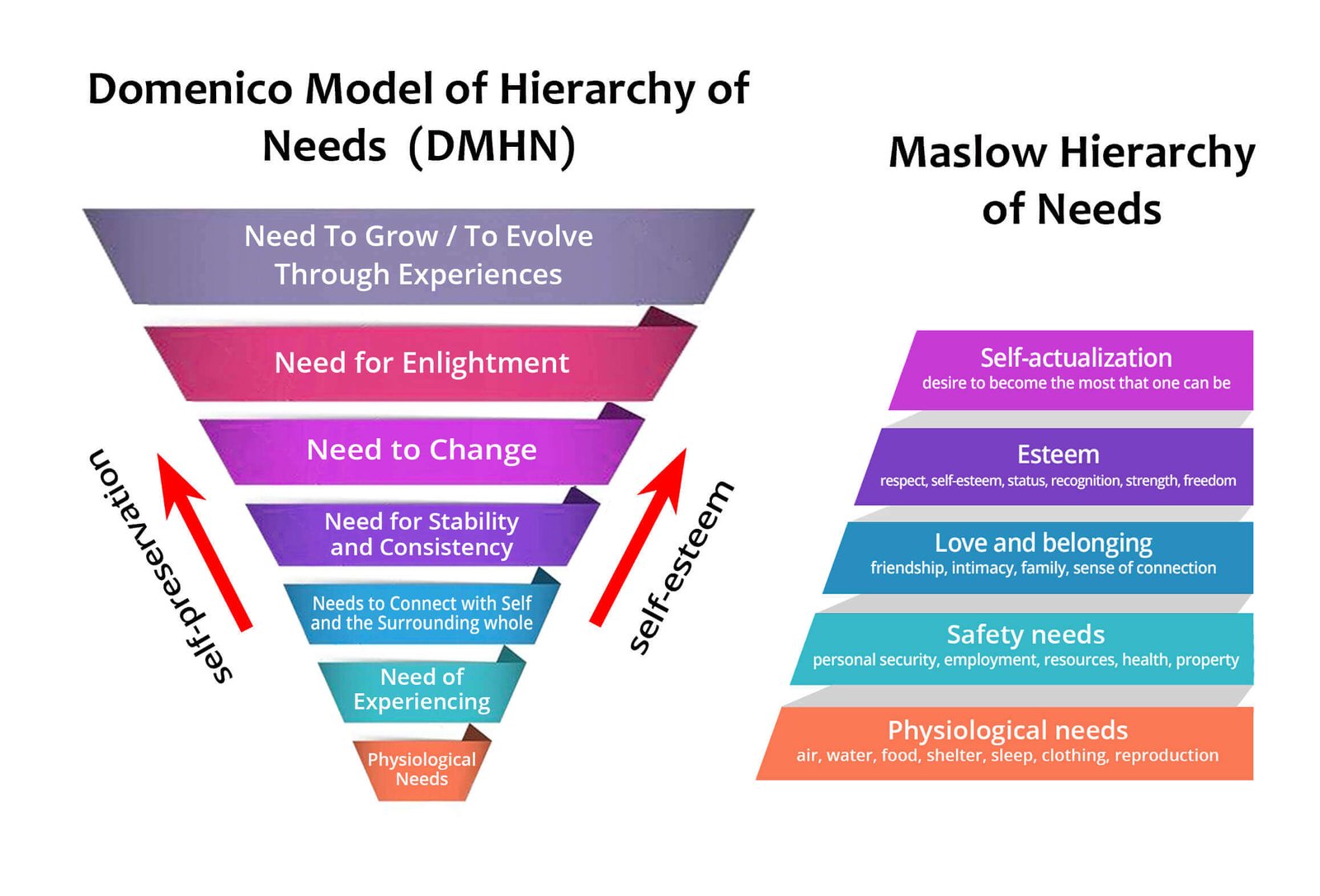In this research article, Maslow hierarchy of needs is compared and contrasted with Domenico’s model of human needs. We can start by noting that physiological needs sit at the bottom of both models. Physiological needs must be met before we move up through either model. Food, water, shelter, and reproduction are essential needs that must be met constructively. As Human Beings fail to satisfy their needs in the lower levels of the Model, they are experiencing a large variety of negative emotions: insecurity, inadequacy, anger, resentment, confusion, and loneliness. In this Realm, stress and fear also play an important role in driving people deeper and deeper into confusion, depression, and violence.
The following tier of the DMHN is The Need of Experiencing: the need to live through experiences, through our senses, and our emotions. The Need for the Experience phase is not present in Maslow’s Model; however, it is an integral part of the DMHN. We need to experience that will remain in our nature throughout all our lifetimes. Evolution is the subsequent need in the model. Studies indicate that the presence and absence of positive events, such as having needs met, are more strongly associated with the intensity of positive experiences.
We can immediately see the main difference between the two models: the inverse nature of the DMHN. The inverse pyramid indicates growth in awareness, the expansive nature of human needs, and the ever-growing need for enlightenment. Another important difference is that the safety needs Maslow defined as self-preservation in the DMNH. The self-preservation need is placed outside of the pyramid, and it is increasingly growing alongside the higher needs.
Keywords
Maslow hierarchy of needs, Domenico’s Model of Human Needs, DMHN, and Emotional Needs. Physiological needs.
Introduction
Comparing and contrasting the Maslow Hierarchy of Needs (Cherry, 2015) with the Domenico Model of Hierarchy of Needs (DMHN), we can start by noting that physiological needs sit at the bottom of both models. Physiological needs must be met before we move up through either model. Food, water, shelter, and reproduction are essential needs that must be met constructively. If individuals are unable to manage this, they may engage in destructive psychological processes and behaviors to satisfy these needs (Staub, 1999).
Expanding on Shaub’s research, we are connecting the physiological needs with the emotional ones highlighted in the DMHN Realm of Negative Emotions (Meschino, 2023). As Human Beings fail to satisfy their needs in the lower levels of the Model, they are experiencing a large variety of negative emotions: insecurity, inadequacy, anger, resentment, confusion, and loneliness. In this Realm, stress and fear also play an important role in driving people deeper and deeper into confusion, depression, and violence. At this stage, we can also see the descending parable of self-esteem and the instinct of self-preservation. Emotional needs are equally important as physiological needs. At times, the lack of basic emotional needs can trigger negative ripple effects, causing serious issues for the individual.
The following tier of the DMHN is The Need of Experiencing: the need to live through experiences, through our senses, and our emotions. The Need for the Experience phase is not present in Maslow’s Model; however, it is an integral part of the DMHN. We need to experience that will remain in our nature throughout all our lifetimes.
Evolution is the subsequent need in the model. Studies indicate that the presence and absence of positive events, such as having needs met, are more strongly associated with the intensity of positive experiences. Conversely, the presence and absence of negative events, such as frustration, are more strongly associated with the intensity of negative outcomes (Colquitt, Long, Rodell, & Halvorsen-Ganepola, 2015; Ferris, Johnson, Rosen, Djurdjevic, Chang, & Tan, 2013). Having the phase of Experiencing shown higher up in the model indicates that it is key to the fulfillment of human needs and to the advancement to and of higher stages.
We can immediately see the main difference between the two models: the inverse nature of the DMHN. The inverse pyramid indicates growth in awareness, the expansive nature of human needs, and the ever-growing need for enlightenment. Another important difference is that the safety needs Maslow defined as self-preservation in the DMNH. The self-preservation need is placed outside of the pyramid, and it is increasingly growing alongside the higher needs. The need for self-preservation is already very much present in the lower realms of the model. The instinct for self-preservation will increase with the other needs as we go higher, though assuming a deeper meaning and a higher intensity. As we experience life through our senses and our emotions, we need to connect with our surrounding world as well as within ourselves.
Connecting to ourselves entails understanding our emotions, our logic, and our past experiences, gaining an understanding of who we are and at what stage of our evolution we are, what our driving forces are, how our experiences have changed us, and ultimately how much we know about ourselves. As far as connecting with the surrounding world, there is an innate need for us to feel connected with nature and with animals. The need for self-preservation is always present in human evolution, increasing in intensity and awareness as we move to the other stages.
The need for stability is consistent throughout our evolution, and the need for consistency in our daily lives goes along with many of our other needs. The need for self-preservation is very present in this phase, which contributes to the rise of the need for stability and consistency. The Stability phase can be seen as a pattern-establishment construct, where stability is shown in a well-structured, routine-based, and consistent way of living. Once stability is no longer present and life patterns are being challenged, the need for change arises the need to create something new. The need to change the current system becomes, at times, a necessity. In many instances, this is fueled by enhanced self-preservation instincts playing a crucial role.
The Love and Belonging phase in Maslow’s model corresponds to the Connecting with Self and Surrounding World stage in the DMHN. What the Domenico Model does is define the word “love” as a connection, not only within oneself but also with the outside reality. Belonging is another facet of connecting, one where there is a sense of connection. This need includes interpersonal connections, a sense of community membership, and affectionate feelings.
This is the most challenging need, as it necessitates the cooperation of others. According to Baumeister et al. (1995) and Demirdag (2016), its absence causes severe deprivation, perceived stress, and several other negative effects (Baumeister et al., 1995; Demirdag, 2016). In contrast, the satisfaction of the needs for love and belonging promotes self-actualization and is positively associated with positive well-being and life satisfaction (Kasser & Ryan, 1999). Decy et al. (2001) also discovered a positive correlation between need satisfaction and general self-esteem, which is the next stage of the DMHN Model (Decy et al., 2001).
In the DHMN, self-esteem is seen as a self-perception attitude geared to expansion as we move up in the model. Self-esteem is directly connected with the expansive mode of the Hierarchy of Needs, and at each level, it becomes more logical, more intense, and more positive. Self-esteem is as expansive as self-preservation; however, they are external to the model. Most studies reported that higher self-esteem was associated with healthier behavior.
The next level up is the Need to Change. Change is a necessary process. It is a process that is essential since the Stability stage is always challenged. Although we would like to remain in this stage with our established routines and patterns, outside variables are numerous and can shake up the status quo, bringing about the need for change. Probably one of the toughest leaps in this model, Change rearranges patterns, and it questions current norms. Change, for human beings, is a complex process; it is a process of breaking old habits and establishing new ones. It is a process of establishing new thinking models that create new routines — thinking models that also reflect how someone perceives and feels their surrounding reality.
Through Change, human beings strive to reach Enlightenment. Enlightenment is a state of heightened awareness of the self and the surrounding world, a state of heightened connection with oneself and the life around us. This is a state where fear is absent, supported by enhanced human logic and strong sentiments: a state of completeness, a state of balance, and positivity. At this stage, there is also an elevated sense of self-esteem and self-preservation, as we can see from our model. The appreciation and preservation of the self-lead to mental, physical, and emotional health becoming a priority. In this phase, there is also a strong desire for knowledge, and a fervid desire to continue to search through human nature by experiencing.
The need to grow through experience is our next phase: one that is of a heightened discovery of the world surrounding us supported by a feeling of fearless well-being. This leads to a state of willingness and readiness to share with the people most in need, a readiness to share the journey with others, to inspire and to be inspired on each of our journeys.
REFERENCES:
Baumeister, R. F., & Leary, M. R. (1995). The need to belong: desire for interpersonal attachments as a fundamental human motivation. Psychological bulletin, 117(3), 497.
Cherry, K. (2015). The Five Levels of Maslow’s Hierarchy of Needs. [Online] About.com
EducationAvailableat:
http://psychology.about.com/od/theoriesofpersonality/a/hierarchyneeds.htm.
Colquitt, J. A., Long, D. M., Rodell, J. B., & Halvorsen-Ganepola, M. D. (2015). Adding the “in” to justice: A qualitative and quantitative investigation of the differential effects of justice rule adherence and violation. Journal of applied psychology, 100(2), 278.
Deci, E. L., Ryan, R. M., Gagné, M., Leone, D. R., Usunov, J., & Kornazheva, B. P. (2001). Need satisfaction, motivation, and well-being in the work organizations of a former eastern bloc country: A cross-cultural study of self-determination. Personality and social psychology bulletin, 27(8), 930-942.
Demirdag, S. (2016). The relationship between faculty members’ school culture and burnout levels is based on the perceptions of teacher candidates. E-International Journal of Educational Research, 7(3), 49-62.
Ferris, D. L., Johnson, R. E., Rosen, C. C., Djurdjevic, E., Chang, C. H. D., & Tan, J. A. (2013). When is a success not satisfying? Integrating regulatory focus and approach/avoidance motivation theories to explain the relationship between core self-evaluation and job satisfaction. Journal of Applied Psychology, 98(2), 342.
Staub, E. (1999). The roots of evil: Social conditions, culture, personality, and basic human needs. Personality and Social Psychology Review, 3(3), 179-192.
Kasser, V. G., & Ryan, R. M. (1999). The Relation of psychological needs for autonomy and relatedness to vitality, well‐being, and mortality in a nursing home. Journal of Applied Social Psychology, 29(5), 935-954.
Author Name: Dr. Domenico Meschino
Title: Teacher, Author, Business Owner
Email: luminosaglobal@gmail.com
Address: Chicago IL, USA
Website: drmeschino.net









